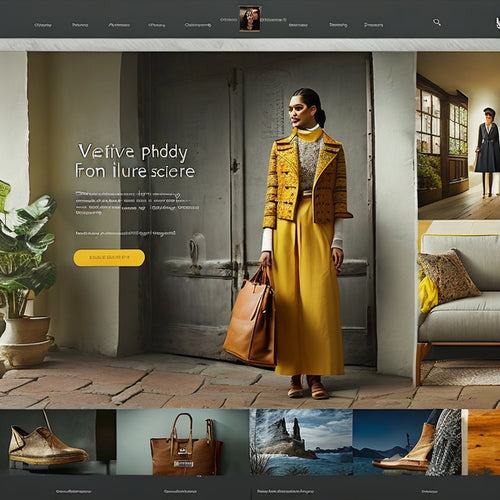
Discover Secrets to Profitable Online Art Sales
Share
You're ready to turn your art into a profitable online business, but where do you start? First, set up your business foundation by registering your business and choosing a unique name. Next, decide on a medium that fits your style, whether it's physical or digital art. Then, master online art marketing by showcasing your work on social media, collaborating with influencers, and building an email list. You'll also need to create a profitable online store with a customized platform and branding strategies. Finally, craft a pricing strategy that resonates with your target audience. Now, you're one step closer to revealing the secrets to profitable online art sales, and there's even more to explore.
Key Takeaways
• Register your online art business and choose a unique name to lay a solid foundation for success.
• Select the right art medium, whether physical or digital, to shape your creative journey and business model.
• Develop a social media strategy to engage with your audience, showcase your unique style, and drive traffic to your online platform.
• Craft a pricing strategy based on production costs, target audience, and competitor analysis to maximize online art sales.
• Build a profitable online store with a seamless user experience, strong branding, and design customization to attract and convert customers.
Setting Up Your Art Business
As you begin your online art business journey, registering your business and choosing a unique name that highlights your artistic style is a crucial first step. This sets the foundation for a professional and legitimate business.
You'll need to decide on a business structure, such as a sole proprietorship or LLC, and check your state's requirements for business licenses. Don't forget to research tax implications for each structure, as they can affect your bottom line.
Proper registration will also help you open a business bank account, necessary for separating personal and business finances. By taking care of these essential steps, you'll be well on your way to building a successful and profitable online art business.
Selecting the Right Medium
When deciding on a medium for your online art business, you're faced with a critical choice that will shape your creative journey and business model: physical art or digital art, each with its unique benefits and challenges.
Physical art offers a tangible value and sensory experience, allowing collectors to connect with your work on a deeper level.
Digital art, on the other hand, has surged in popularity, offering lower production costs and the ability to easily reproduce and distribute your work. Exploring digital tools can help you create stunning digital pieces, while understanding traditional methods can add depth to your physical art.
Mastering Online Art Marketing
You've successfully chosen your medium, now it's time to showcase your art to the world by mastering online art marketing, a pivotal step in getting your work seen and sold.
Develop social media strategies that highlight your unique style and engage with your audience. Collaborate with influencers who share your artistic vision to expand your reach.
Build an email list and create limited-time offers to incentivize sales. Use promotional graphics that grab attention and drive traffic to your online platform.
Building a Profitable Online Store
By selecting the right e-commerce platform and customizing it to showcase your unique brand, you're well on your way to building a profitable online store that effectively sells your art.
With various e-commerce platforms available, choose one that aligns with your business goals and needs.
Next, focus on design customization to reflect your brand's personality and aesthetic. This will help you establish a strong online presence and attract potential customers.
Implement branding strategies that resonate with your target audience, fostering customer engagement and loyalty.
A well-designed online store won't only showcase your art but also provide a seamless user experience, increasing the chances of converting visitors into buyers.
Pricing Strategies for Success
Crafting a pricing strategy that resonates with your target audience is essential to converting browsers into buyers and maximizing your online art sales. You need to assess your production costs, target audience's willingness to pay, and competitor analysis to determine the sweet spot.
Discount promotions can create buzz, but be cautious not to devalue your art. Instead, focus on value-based pricing, where the price reflects the art's intrinsic value. A tiered pricing model can also work wonders, offering different versions of your art at varying price points. This way, you can cater to a broader audience and increase your online art sales.
Growing Your Customer Base
Expanding your customer base requires intentionally building relationships with potential buyers, fostering a sense of community, and strategically leveraging social media platforms to increase brand visibility.
You can achieve this by:
-
Identifying your target audience and creating content that resonates with them.
-
Implementing effective outreach strategies, such as email marketing and collaborations with other artists.
-
Focusing on customer retention by offering exceptional customer service and loyalty programs.
- Utilizing social media platforms to share behind-the-scenes content, sneak peeks, and exclusive offers to keep your audience engaged.
Scaling Your Art Business
As your art business gains momentum, you'll need to strategically scale your operations to meet growing demand, increase efficiency, and maintain profitability.
This involves expanding your reach through new marketing channels and partnerships. Consider expanding internationally to tap into new markets and collaborating with influencers to increase brand visibility.
You can also explore new product lines or services to diversify your income streams. To guarantee a smooth shift, prioritize process automation, outsourcing tasks, and investing in scalable infrastructure.
Frequently Asked Questions
How Do I Handle Copyright Infringement of My Online Art?
"Stealing thunder: protect your online art from sneaky thieves! You'll want to watermark your work, register for copyright protection, and stay vigilant for enforcement - it's your art, own it!"
Can I Sell Art Online as a Non-Us Citizen or Resident?
As a non-US citizen or resident, you can sell art online, but be aware of international sales legal considerations, such as taxes, copyright laws, and cultural differences in the global market.
What Tools Can I Use to Create Digital Art for Online Sales?
'Craft enchanting digital art with ease, using fantastic digital drawing software like Adobe Photoshop, Illustrator, or Sketchbook Pro, paired with fabulous graphic tablets like Wacom or Huion, to create stunning pieces for online sales.'
How Do I Price Art That Combines Physical and Digital Elements?
When pricing art that combines physical and digital elements, you'll need to evaluate the value of both aspects. Research your market to determine what buyers are willing to pay, and assess the value of your unique creative process.
Can I Sell Art Online if I'm Not a Professional Artist?
You can definitely sell art online, even as an amateur artist or side hustle! With passion and dedication, you can build a loyal customer base and monetize your creative skills, regardless of your professional status.
Related Posts
-
Quick Comparisons of the Best Shopify Sitemap Apps
This article provides a comprehensive analysis of the top Shopify sitemap apps available in the market. The objectiv...
-

How Do I Improve My Shopify Store Design
This article aims to provide informative and knowledgeable insights into improving the design of a Shopify store. By...
-

Affiliate Shopify Apps Drive Sales by Incentivizing External Partners or Customers
This article discusses the role of affiliate Shopify apps in driving sales by incentivizing external partners or cus...

